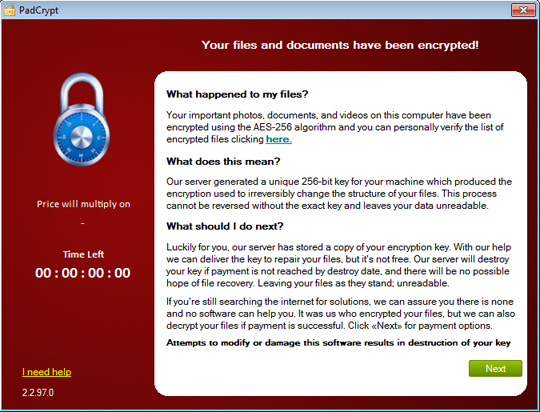RANSOM_CRYDAP.C
Ransom:MSIL/Crydap.A (Microsoft); Ransom.PadCrypt (Malwarebytes); Atros3.LQD (AVG)
Windows


Threat Type: Trojan
Destructiveness: No
Encrypted: No
In the wild: Yes
OVERVIEW
Downloaded from the Internet, Dropped by other malware
This Trojan arrives on a system as a file dropped by other malware or as a file downloaded unknowingly by users when visiting malicious sites.
It requires its main component to successfully perform its intended routine.
TECHNICAL DETAILS
1,478,656 bytes
EXE
Yes
23 Mar 2016
Displays windows, Drops files
Arrival Details
This Trojan arrives on a system as a file dropped by other malware or as a file downloaded unknowingly by users when visiting malicious sites.
Installation
This Trojan creates the following folders:
- %Application Data%\PadCrypt
(Note: %Application Data% is the Application Data folder, where it usually is C:\Documents and Settings\{user name}\Application Data on Windows 2000, Windows Server 2003, and Windows XP (32- and 64-bit); C:\Users\{user name}\AppData\Roaming on Windows Vista (32- and 64-bit), Windows 7 (32- and 64-bit), Windows 8 (32- and 64-bit), Windows 8.1 (32- and 64-bit), Windows Server 2008, and Windows Server 2012.)
Other System Modifications
This Trojan adds the following registry keys:
HKEY_LOCAL_MACHINE\Software\Microsoft\
Tracing\package_RASAPI32
HKEY_LOCAL_MACHINE\Software\Microsoft\
Tracing\package_RASMANCS
HKEY_CURRENT_USER\Software\PadCrypt
HKEY_CURRENT_USER\Software\PadCrypt\
Files
Dropping Routine
This Trojan drops the following files:
- %Application Data%\machine_id.dat
(Note: %Application Data% is the Application Data folder, where it usually is C:\Documents and Settings\{user name}\Application Data on Windows 2000, Windows Server 2003, and Windows XP (32- and 64-bit); C:\Users\{user name}\AppData\Roaming on Windows Vista (32- and 64-bit), Windows 7 (32- and 64-bit), Windows 8 (32- and 64-bit), Windows 8.1 (32- and 64-bit), Windows Server 2008, and Windows Server 2012.)
Other Details
This Trojan requires its main component to successfully perform its intended routine.
NOTES:
This malware displays the following:


SOLUTION
9.800
12.420.04
23 Mar 2016
12.421.00
24 Mar 2016
Step 1
Before doing any scans, Windows XP, Windows Vista, and Windows 7 users must disable System Restore to allow full scanning of their computers.
Step 2
Note that not all files, folders, and registry keys and entries are installed on your computer during this malware's/spyware's/grayware's execution. This may be due to incomplete installation or other operating system conditions. If you do not find the same files/folders/registry information, please proceed to the next step.
Step 3
Delete this registry key
Important: Editing the Windows Registry incorrectly can lead to irreversible system malfunction. Please do this step only if you know how or you can ask assistance from your system administrator. Else, check this Microsoft article first before modifying your computer's registry.
- HKEY_LOCAL_MACHINE\Software\Microsoft\Tracing\package_RASAPI32
- HKEY_LOCAL_MACHINE\Software\Microsoft\Tracing\package_RASMANCS
- HKEY_CURRENT_USER\Software\PadCrypt
- HKEY_CURRENT_USER\Software\PadCrypt\Files
Step 4
Search and delete these folders
- %Application Data%\PadCrypt
Step 5
Search and delete these files
- %Application Data%\machine_id.dat
Step 6
Scan your computer with your Trend Micro product to delete files detected as RANSOM_CRYDAP.C. If the detected files have already been cleaned, deleted, or quarantined by your Trend Micro product, no further step is required. You may opt to simply delete the quarantined files. Please check this Knowledge Base page for more information.
Did this description help? Tell us how we did.
